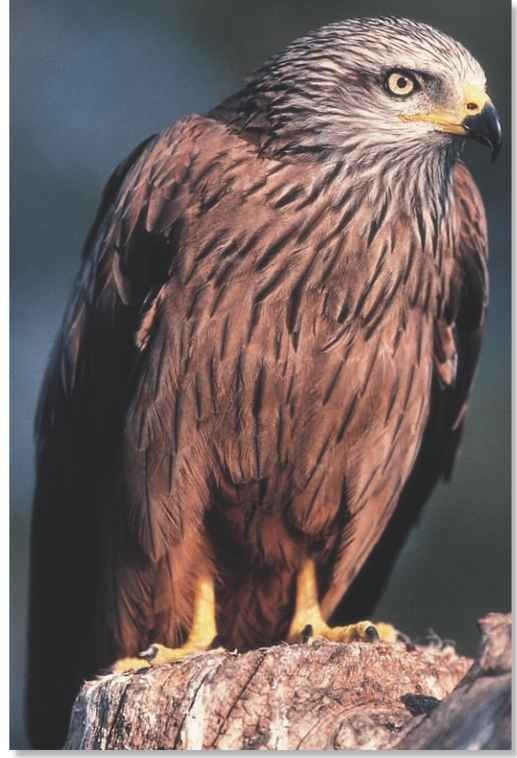ORDER
Falconiformes
FAMILY
Accipitridae
GENUS & SPECIES
KEY FEATURES
• Graceful aerobatics and a buoyant flight are its trademark
• Constantly adjusts the angle of its wings and deeply forked tail when airborne
• Consumes carrion in large quantities, often feeding at dumps
• An opportunist that frequently steals food from other large birds or takes over their old nests
WHERE IN THE WORLD?
Scarce, with a scattered range across Europe; about 90% of the birds breed in Germany, France and Spain, a small but growing number in Britain, a few in Morocco and on the Cape Verde Islands
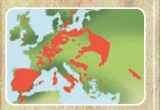
Lifecycle
Able to soar and hang in the air without visible effort, the red kite looks for food from its aerial “perch.” It feeds mainly on carrion or takes small prey by surprise.
HABITAT
The red kite, a bird of lightly wooded terrain, breeds and roosts in stands of trees and hunts over open areas. In the south of its range, it’s found mainly in forested valleys and areas of traditional, mixed farming. In the north, it occurs on nonintensive farmland with small fields and hedges, interspersed with woods, rough pasture and moorland.
The kite’s home range varies in area. In central Wales, some stay within 1-2 miles of their roosts and nests; others travel up to 9 miles or more for food.
In winter, the red kite uses a wider variety of habitats, ncluding treeless agricultural land, scrub and wetlands. It often visits garbage dumps at this time of year Demonstrating its opportunistic nature, the red kite also feeds at the roadside, on wildlife fatalities, as well as outside slaughterhouses. In medieval times, red kites occurred in large numbers in many of the cities of western Europe — until improved human cleanliness reduced the amount of food available.
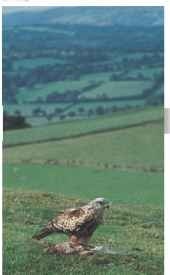
A Human nature Kites use man-made habitats, like farmland.
Kites flown by humans get their name from the bird.
The isolated subspecies of red kite on the Cape Verde Islands is smaller and darker than red kites elsewhere.
A pair of red kites often weaves pieces of plastic, rags or paper into their nest.
Until the 16th century, red kites were a common sight in London.
FOOD & HUNTING
The kite has a varied diet, which depends upon the food available at a particular time of year. In the breeding season, it takes a greater proportion of live prey: mammals up to the size of a hare and birds, including small species and the young of larger ones, such as crows. Garbage and carrion, especially dead sheep, become more important in winter. The red kite also steals food from herons and other predatory birds.
To locate food, the kite circles high above the ground or glides at treetop level, diving to catch live prey by surprise. It can catch birds and insects in the air, but only rarely engages in a chase, as it lacks the speed of falcons or hawks.
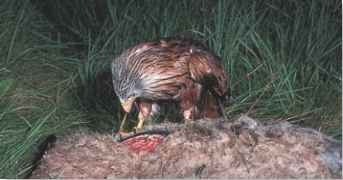
JUNK FOOD
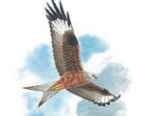
Circle…
A red kite circles high overhead, scanning the ground below as it maneuvers with great skill.
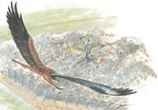
Glide…
Once the kite spots a source of food, it begins to lose altitude by gliding slowly in wide circles.
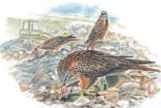
Scavenge…
Joining others at a dump, it eagerly feeds on any scraps of animal matter that it can find.

Disturbed
In many places, kites are very shy and quickly take to the air at the first signs of disturbance.
BREEDING
In March and April, at the start of the breeding season, pairs perform display flights over their territory, circling at great height or chasing each other Rival males may challenge each other by seizing the opponent’s talons or cartwheeling down with their talons interlocked.
Pairs may build a nest or add to one that they’ve built during previous seasons. They may also take over the old nest of a buzzard or raven. After mating, the female usually lays two eggs, incubating them for about a month. The female broods the newly hatched chicks for two weeks, while her mate brings food. Later, when the chicks can feed themselves, the female also hunts for her offspring. Chicks fledge at about seven weeks old.
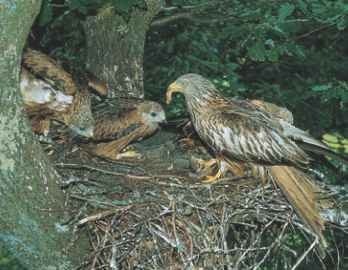
A Bite-sized
The female passes morsels of meat to her brood.
CONSERVATION
The long-term decline of the once-common red kite, which accelerated during the 19th century, resulted mainly from persecution by farmers and gamekeepers. It feeds largely on carrion, but is often blamed for the death of sheep and lambs. Now, with the cooperation of farmers and with legal protection, it’s recovering in western Europe. A major conservation program also involves releasing juveniles from the healthy Spanish i population into Britain.
BEHAVIOR
For much of the time, the red kite is solitary. Juveniles, in particular, may wander for one or more years, until they’re able to breed. Kites sometimes gather to feed at garbage dumps or rest in communal roosts, especially in winter
Most red kite populations breeding in northern and central Europe migrate south or southwest to spend the winter in regions fringing the northern Mediterranean. Birds from the southern part of the range remain in the same areas all year, and there is now an increasing tendency for northern birds to do likewise. Red kites may migrate in small groups, although usually they migrate singly among flocks of other birds of prey.
Unlike many birds of prey, home ranges of red kites often overlap. Neighboring pairs show little hostility to one another, defending only a restricted area around nest sites. The kite uses high-pitched, mewing calls to warn intruders, indicate alarm or simply to stay in contact with others — and is more vocal in breeding seasons.
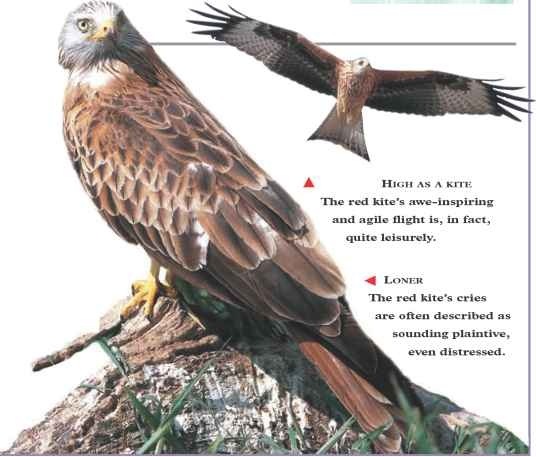
PROFILE
Red Kite
The red kite is a multipurpose bird of prey, adapted to catch live prey as well as to make a living scavenging on scraps and carrion.
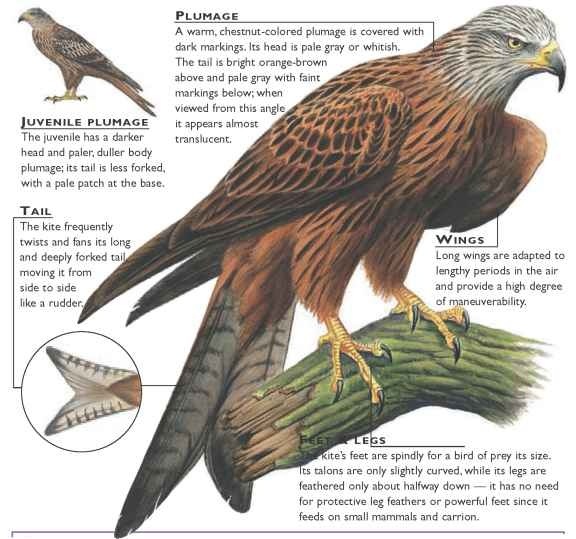
CREATURE COMPARISONS
The red kite’s closest relative, the black kite (Milvus migrans), is more abundant and widespread
found throughout the Old World. It has adapted to life alongside humans and is a common scavenger on city streets from Africa to eastern Asia. As well as human refuse and carrion, it eats large amounts of fish — unlike its red relative
and is often found near freshwaterThe ranges of both birds overlap in parts of Europe, but the red kite is easily distinguished from the black kite by its deeply forked tail and the light patches near its wingtips.
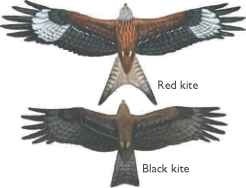
| VITAL : Weight |
STATISTICS Male 1.52 lbs.; female 2-2.5 lbs. |
| Length | About 2′ |
| Wingspan | 5-6′ |
| Sexual Maturity | 2-4 years |
| Breeding Season | Late March - -July |
| Number of Eggs | 2-4 |
| Incubation Period | 31-32 days |
| Fledging Period | 50-60 days |
| Breeding ‘ Interval | 1 year |
| Typical Diet | Carrion, mammals, birds, reptiles, invertebrates |
| Lifespan | Up to 26 years |
RELATED SPECIES
• The 237 species in the large family Accipitridae include almost all birds of prey. Of these, 33 species are members of the kite subgroup and include the American swallow-tailed kite (Elanoides forficatus), the snail kite (Rostrhamus sociabilis), which feeds on aquatic snails, and the brahminy kite (Haliastur indus), a scavenger living near human habitation in India and Southeast Asia.
